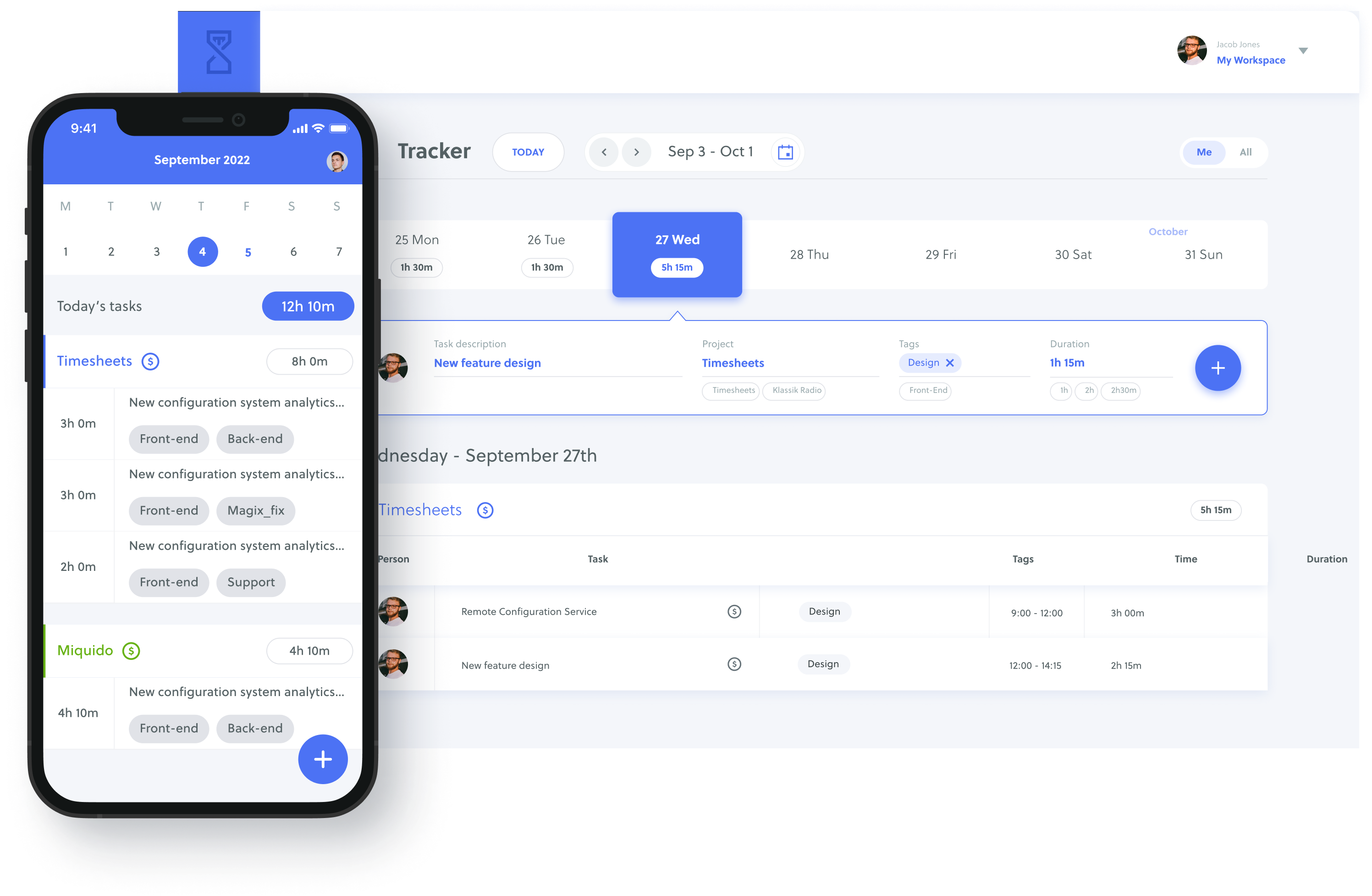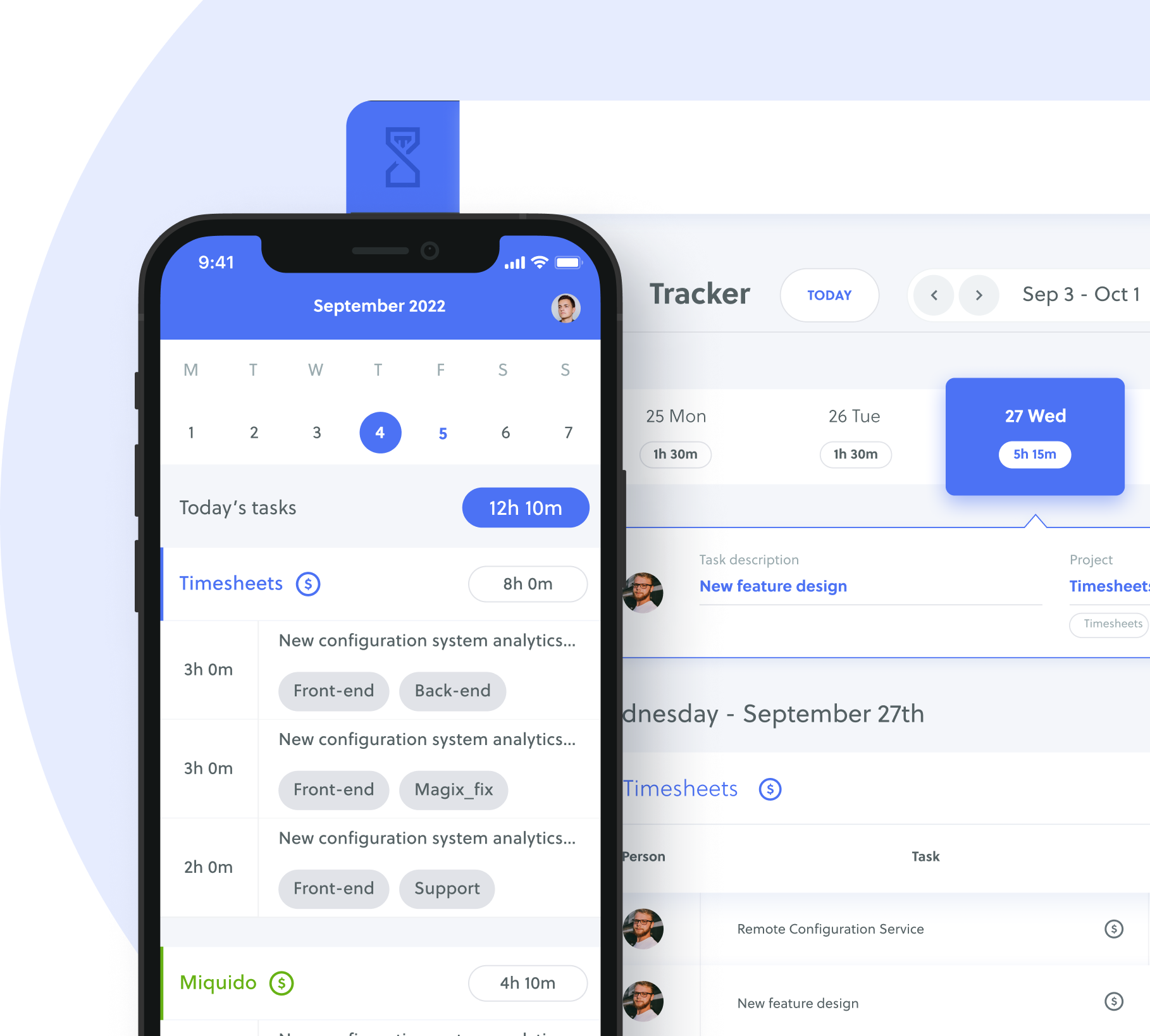Many folks are unsure of the difference between PTO (paid time off) and vacation. You might think that they’re the same thing, or that one is just a nicer word for the other. But, there’s actually a big difference between the two concepts.
As a business, it’s important that you create a happy and productive workspace for employees so you stand a chance in the ever-growing war for talent (63% said they’d turn down a job offer if it didn’t include PTO).
That’s why at Quidlo, we will explore what each one means, how they differ, the pros and cons of each, and how to implement them the right way in your own company.
Ready? Let’s go.
Table of Contents
The short answer: Difference between PTO and Vacation Time
The main difference between paid time off (PTO) and paid vacation time (PVT) is that PVT is for vacation days only, while PTO can be used for any purpose – whether that’s vacation, sick days, personal days, pregnancy, family emergencies, or anything else. With PTO, employees have more flexibility in how they use their time off.

Let’s dive deeper into the specifics of both, so you can see what’s right for your business.
What is PTO?
Paid time off (PTO) is a type of leave that encompasses everything from vacations to paid sick leave. In other words, PTO is any day that an employee can use to take off from work for personal reasons. According to Zippia research, the average PTO in the United States private sector is 10 days (excluding paid holidays and sick days).
Unlike other leave plans, PTO arrangments don’t separate out different types of leave. Instead, it lumps everything together into one pool of time that employees can use as they see fit. So a PTO can be used for:
- Vacations
- Staycations
- Mental health days
- Doctor’s appointments
- Family emergencies
Generally speaking, PTO is a use-it-or-lose-it policy. This means that if employees don’t use their PTO by the end of the year, they will forfeit any remaining days. Some companies have a “rolling” PTO policy, which allows employees to carry over up to a certain number of days into the next year. For example, an employee might be able to carry over 10 days of PTO from 2020 into 2021.
What are the pros and cons of a paid time off policy?
There are several pros and cons of PTO that employers should consider before implementing a policy.
Advantages of PTO
PTO is great for a number of reasons – the biggest being that it’s an opportunity for employees to catch a break for any emergencies. In turn, we see that:
- PTO helps employees maintain a work-life balance. This is especially important for parents who need to take care of their children or elderly parents during emergencies.
- The competitive advantage. Offering employees paid time off is a great way to attract and retain top talent. In fact, a survey published in the Harvard Business Review found that workers may be willing to settle for a lower salary for more flexible hours and PTO time. So for many small businesses, it could be the leg up they need to compete for talent against larger employers. That’s why generous and flexible PTO benefits are becoming a key recruitment and retention strategy.
- Save on administrative costs. Instead of providing separate sick and vacation days which need to be vetted case-by-case (draining more resources), PTO lumps them into one category. Therefore, it reduces the amount of time spent on managing employee leave.
- Employees feel appreciated. By providing PTO, employers are sending a message to their employees that they’re valued and that their well-being is important to the company. This feeling of appreciation can go a long way in boosting morale and fostering a positive work environment.
But “two-thirds of employees say they hear very little about [using] vacation time from their companies,” says Kate Denis (lead researcher for a survey of more than 4,000 U.S. workers on their vacation habits). This creates the assumption that taking PTO is frowned upon when in reality, the research has shown that 78% of bosses agree it can improve an employee’s focus and 81% say it can alleviate burnout.
Point: It’s a good idea to make it clear to your team that you support away-time to foster a work culture that promotes breaks because often, employees need reminding that it’s okay (and encouraged!) to take them.
Disadvantages of PTO
While PTO has its advantages, there are also some potential drawbacks employers should keep in mind.
- PTO can be abused – if employees know they have a certain number of days they can take off per year, they may be inclined to use them all, even if they don’t really need them. This can lead to slacking and a decrease in productivity.
- PTO can be difficult to manage – if you have a lot of employees, it can be tough to keep track of who is taking time off and when. This is especially true if your company has a lot of remote workers.
- PTO can be used as a bargaining tool – some employees may use their PTO as a way to get more money or other benefits from their employer. For example, an employee may threaten to quit unless they’re given more vacation days.
- PTO can be unfair – some employees may feel like they’re not getting as much PTO as others, which can lead to envy and resentment. This is something you should be mindful of when writing your policies and expectations.
What is Paid Vacation Time?
Paid vacation time (PVT) is a benefit that some employers offer to their employees. It’s a set number of days that workers can take off each year for vacation, and they’re paid for the time they’re away. For example, an employer might offer 5 PVT days to all employees. This means that employees can take up to 5 days off per year, and they’ll still get paid for those days.
Reasons to Offer Vacation Time
- People are much happier with their jobs – 68% of employees report they’re more satisfied with their jobs when employers encourage vacations.
- You improve employee retention and loyalty – show your workers that you care about their well-being and they’ll be more likely to stick around. For example, JANCOA (janitorial services company) slashed its retention problems from 360% to 60% in two months after adding a third week of vacation.
- Employees are more productive when they’re given time to relax – A 2018 survey by the American Psychology Association found that 66% of workers had more energy, 57% felt more motivated and less stressed, and 58% said they were more productive after vacation time. That same study found that 55% reported their work quality was also better.
How to Develop PTO and Vacation Policies
If you’re an employer, you need to decide whether you want to offer PTO or vacation time (or both). Here are some things to keep in mind when making your decision:
Ask the important questions for an ironclad policy
- Consider your company culture – if your company is fast-paced and doesn’t care how employees use their time off, PTO might be a better option. There won’t be much visibility into what your employees are doing while away from work, but the advantage is that there’s also less paperwork and costs for you.
- Think about your budget – As you can probably imagine, PTO can be more expensive for employers because they’re still paying workers even when they’re not working. Vacation time may be a better option if you’re on a tight budget.
- What do your employees need? And how’s the competition looking? – Some employees may prefer PTO because it gives them more flexibility. If your employees are competing with other companies for vacation days, they may feel like they’re at a disadvantage.
- How soon do employees get to use your leave benefits? Is it a lump sum or accrual agreement? You’ll have to decide whether employees can take advantage of their PTO bank from the date of hire or whether they’ll have to earn it by working through the year – and if it is an accrual system, are we talking monthly or quarterly?
- What happens to unused balances? Think about whether or not employees can either roll over their unused time or lose it if they don’t use it by a set date. Some businesses enforce the use-it-or-lose-it policy to encourage workers to take time off. But this will depend on your state laws.
- For example, in California PTO is a form of earned wages, making this policy illegal in the state. Also, what happens if an employee quits or is fired? This will also depend on your state laws – again in California, employers must pay out unused vacation time, but in other states, like Texas, employers have the freedom to forfeit worker entitlements.
Choose your PTO offering: Different types of PTO (+ How they work)
Did you know that there are different kinds of paid time off? Let’s talk about them briefly.
Unlimited PTO
Unlimited PTO is, as the name suggests, a policy where employees can use their fully paid leave benefit without any restrictions on the number of days they’re gone for (until the annual leave allowance is used up, of course).
This type of policy has become increasingly popular in recent years as companies move away from the traditional 9-5 work-week. Unlimited PTO can be a great way to promote work-life balance and show employees that you trust them to get their work done, regardless of how many days they take off.).
To prevent this policy from interfering with work, employers require employees to coordinate with each other. And if necessary, the employee may report at any time to work to get some tasks done.
Tips for implementing an unlimited PTO policy
- Write clear policies. It would be smart to create a handbook that covers the basics of unlimited vacation time – like eligibility, the request protocol, the approval process, and potential disciplinary action for abuse.
- Request for an official notice of absence. You’ll need to have some kind of formal system for employees to request vacation days (preferably at least 2 weeks in advance). This will help you plan and prepare for an employee’s absence.
- Make sure there’s no pending work on the table. Before approving a vacation request, managers should ensure that there are no near deadlines or projects that are being ditched. That way, this policy doesn’t disrupt a company’s workflow and production. And again, with early notices, there’s time to get the ducks in a row before an employee leaves.
Accrued PTO
Accrued PTO is a type of leave where employees earn and accrue vacation days as they work. For example, an employee might earn one hour of vacation for every 20 hours they work. Most employers have a limit on the number of vacation days that can be accrued in a year, and different accrual arrangements like:
- Daily: With this system, your employees are able to gather PTO time every day for each hour they spend working. You’ll find this system works best with eight-hour shifts and part-time employees.
- Bi-weekly: This system works a little differently, as your employees will earn PTO time every two weeks, and it will increase 26 times annually. This is a good system to use if most of your employees are on salary.
- Monthly: This is the most common way to calculate PTO rates, as employees will earn vacation time each month. You’ll find this system works best if most of your employees are hourly.
- Annually: Works best for employees with long-term contracts and those who are exempt from overtime laws. They will receive their PTO time in one lump sum at the beginning of the year, and they can use it as they please.
The accrual PTO policy is beneficial for employers because it motivates employees to stay with the company for a longer period of time. It also ensures that employees don’t take all their vacation days at once, which can disrupt workflow.
Tips for implementing an accrued PTO policy
- Track employee work hours. This will help you calculate how many vacation hours each employee has earned. For remote teams, this can be a bit difficult – which is why an online time-tracking tool like Quidlo can come in handy. You can assign user roles, tasks, and get an overview of how long each employee is spending on a project (along with monitoring their progress). When you have the hard numbers on record, it will be much easier to calculate and keep track of accrued vacation days.
- Consider using a PTO accrual calculator. This can help take the guesswork out of calculating vacation hours.
- Set a maximum number of vacation days that can be accrued in a year. This will prevent employees from amassing too much vacation time and disrupting workflow.
How to calculate accrued PTO time
- Calculate the paid time off employees earned – this will depend on your conditional PTO policy. Referring to the example mentioned before, you could offer employees one hour of vacation for every 20 hours worked.
- Subtract the amount of paid time off already taken by the employee – If they haven’t used all of it, you can either roll over this amount of cash out of the employee’s accrued time off by multiplying the remaining time by the employee’s hourly rate.
- Make sure to withhold taxes from accrued paid time off before paying your employee.
To give you an example calculation for better understanding, let’s recall the one-hour earned vacation for 20 hours worked sample policy. If an employee worked 1000 hours during that calendar year, they would earn 50 hours of vacation (1000/20=50).
But don’t forget that they’ve used, say, 10 hours of paid time off already. So you’d be left with 40 hours of vacation to pay out (50-10=40).
And finally, you need to multiply the number of vacation hours by the employee’s hourly rate. So if their hourly rate is $20, you would pay them $800 for their accrued vacation time (40 hours x $20= $800).
Fixed PTO
Fixed PTO is a type of leave where employees are given a set amount of vacation days, regardless of how long they’ve been with the company or how many hours they’ve worked.
This type of policy is beneficial for employers because it’s easier to manage and plan for. It also ensures that all employees are treated equally, regardless of their tenure or position.
Tips for implementing a fixed PTO policy
- Determine how many vacation days you want to offer employees. This will depend on your company’s budget, size, and industry.
- Consider offering more vacation days to employees who have been with the company for a longer period of time. This will help retain top talent, motivate them to stay with the company, and encourage newer employees to work harder.
- Make sure to withhold taxes from paid time off before paying your employee.
How to use PTO and Vacation Time Effectively: Pro Tips
Now that you know the difference between PTO and vacation time, it’s important to learn how to use your days off effectively. Here are some tips for both employers and employees:
- Don’t save up all your days – If you have a bank of PTO or vacation days, don’t save them all up for one big trip. Studies show that taking small vacations throughout the year is actually better for your mental health. So, try and use a few days here and there to recharge your batteries.
- Take care of any unfinished business – If an employee is about to go on vacation, make sure you tie up any loose ends at work. This way, everyone can relax and enjoy themselves without having to worry about what’s next or be interrupted by any work-related calls and emails.
- Make sure you have backup resources on stand-by – If you’re the one in charge, it’s important to make sure that there is someone who can cover for you while you’re away. This way, the work will still get done and no one has to feel overwhelmed.
- Communicate, communicate, communicate – This is key for both employers and employees. If you’re an employer, make sure your employees know what the policy is and how much time they have available to them. Again, fleshing out your PTO and vacation policies in a handbook is a great way to do this. As an employee, it’s important to communicate with your boss about when you’ll be taking time off well in advance. This way, they can plan accordingly and there won’t be any surprises.
PTO and Vacation Time FAQ
How Much PTO is Normal?
As we mentioned earlier, Zippia says the average PTO in the United States private sector is 10 days (this is excluding paid holidays and sick days).
Furthermore, an Intuit QuickBooks Time annual survey of U.S. employees reveals some more specifics, showing that 69% of employees who report receiving paid time off from their employer get an average of:
- 10.7 vacation days
- 6.5 sick days
- 4 personal days
- 6.5 holidays
- 2 volunteering days
For a total of 29.7 paid days off. However, employees who receive a lump sum of paid time off are only offered an average of 8.8 days. Of course, this number will differ from company to company and state to state. So, it’s important to check with your employer to see what the policy is.
Does PTO Renew Every Year?
This will depend on your company’s policy and state laws. As we mentioned earlier, some companies have a use-it-or-lose-it policy, which means that if you don’t use your PTO by a certain date, you lose it.
Other companies have a rolling-over policy, which allows employees to carry over their unused PTO to the following year. This is a great benefit, as it allows employees to save up their PTO for a big trip or emergency.
Some companies have a hybrid policy, which means that employees can roll over a certain amount of PTO days, but anything above that will be forfeited.
Does PTO Rollover?
This depends on your company’s policy. Some companies allow employees to roll over their unused PTO to the following year, while others have a use-it-or-lose-it policy.
If you’re not sure what the policy is at your company, make sure to check with your boss or HR department. They will be able to give you the most accurate information.
Does PTO Include Vacation Time?
It can. As we mentioned earlier, some companies will lump their vacation days and PTO together, while others will keep them separate.
Does PTO Include Sick Time?
Again, it can. Some companies will lump their sick days and PTO together, while others will keep them separate.
If you’re not sure what the policy is at your company, make sure to check with your boss or HR department. They will be able to give you the most accurate information.
Does PTO Expire?
This will depend on your company’s policy. Some companies have a use-it-or-lose-it policy, which means that if you don’t use your PTO by a certain date, you lose it.
Other companies have a rolling-over policy, which allows employees to carry over their unused PTO to the following year.
Is PTO Taxed?
Paid time off (PTO) or vacation policies do have tax implications. When the employee takes time off, the employer pays them cash compensation, which is taxable for the employee and deductible for the employer.
The amount of taxes withheld from the employee’s paycheck will depend on their tax bracket. For example, if they’re in the 25% tax bracket, $100 of PTO pay would result in $25 being withheld for federal income taxes.
Keep in mind that state and local laws may also apply. For example, some states have laws that require employers to pay out PTO when the employee leaves the company.
If you have any questions about the tax implications of PTO, make sure to speak with your accountant or financial advisor. They will be able to give you the most accurate information.
Is PTO Required by Law?
The short answer is no, PTO is not required by law. In the United States, The Fair Labor Standards Act (FLSA) does not mandate payment for time not worked, like vacations, sick leave, or federal or other holidays. It’s up to the employer and the employee to agree on these things (or the employee’s representative).
However, some states have their own laws that require employers to provide paid time off. For example, California, Massachusetts, Colorado, Connecticut, Maryland, and Rhode Island all have laws that require employers to provide paid sick days.
And, as we mentioned earlier, some states have laws that require employers to pay out PTO when the employee leaves the company. So, it’s important to check with your state’s labor department to see if there are any laws that apply to you.
Final Thoughts – What should I go with?
There is no right or wrong answer when it comes to PTO vs vacation days. We’ve armed you with all the information you need. Now, it’s up to you to weigh the pros and cons and decide what’s best for your company.
If you’re looking to attract more talent, save on HR costs, and deal with fewer headaches with managing employee leave, offering PTO may be the way to go. But, if you want more control over how and when your employees use their vacation days, then offering separate vacation and PTO days may be the better option.
And, if you’re ever unsure about anything, make sure to check with your trusted HR advisor or attorney. They will be able to guide you in the right direction.
Did you find this article helpful? If so, make sure to share it with your friends and colleagues! And, if you’re looking for a timesheet app to help manage your employee leave, be sure to check out Quidlo. We make it easy to track and manage time spent on tasks so you can calculate PTO (if you’re using an accrual system). Plus, our app is super user-friendly and easy to use!







